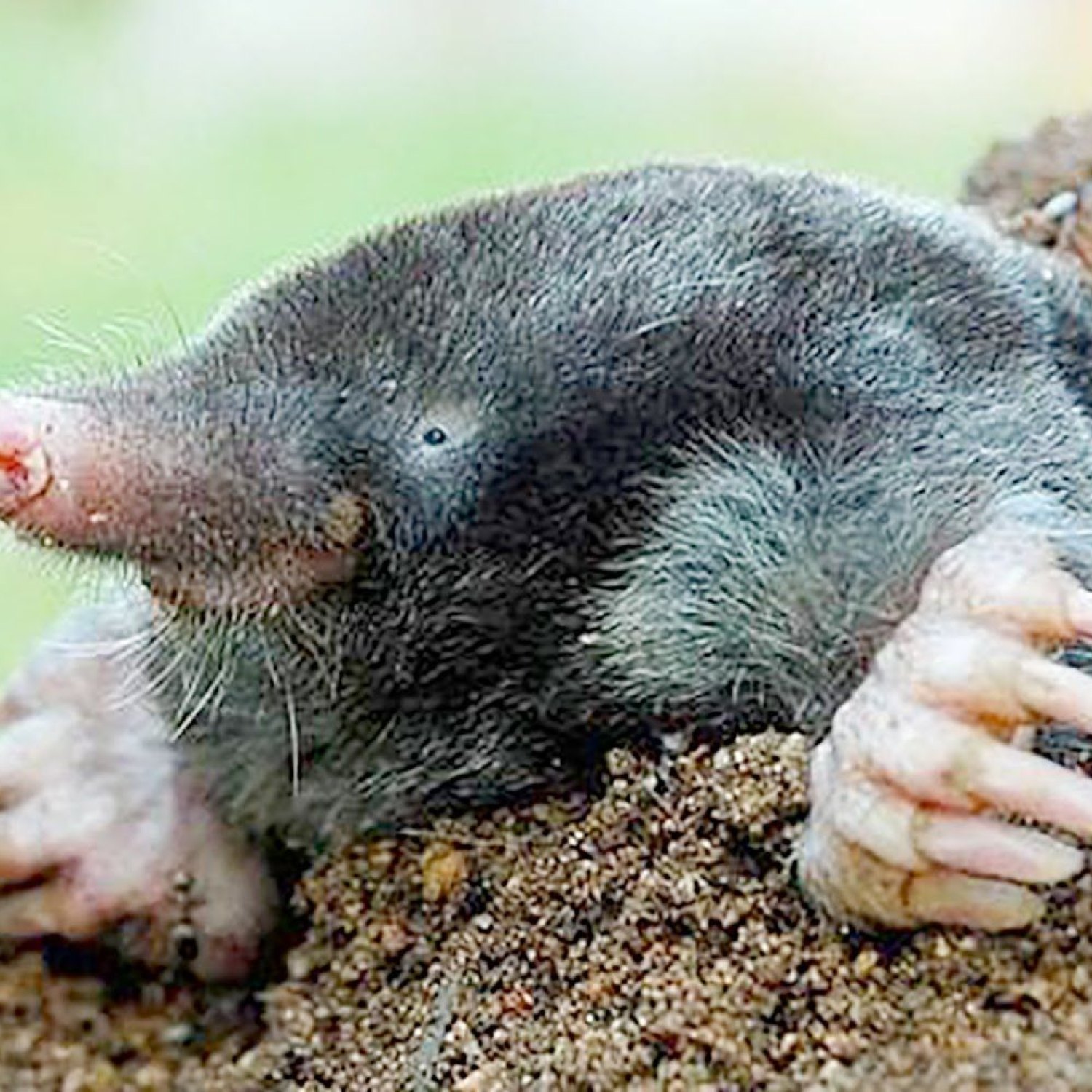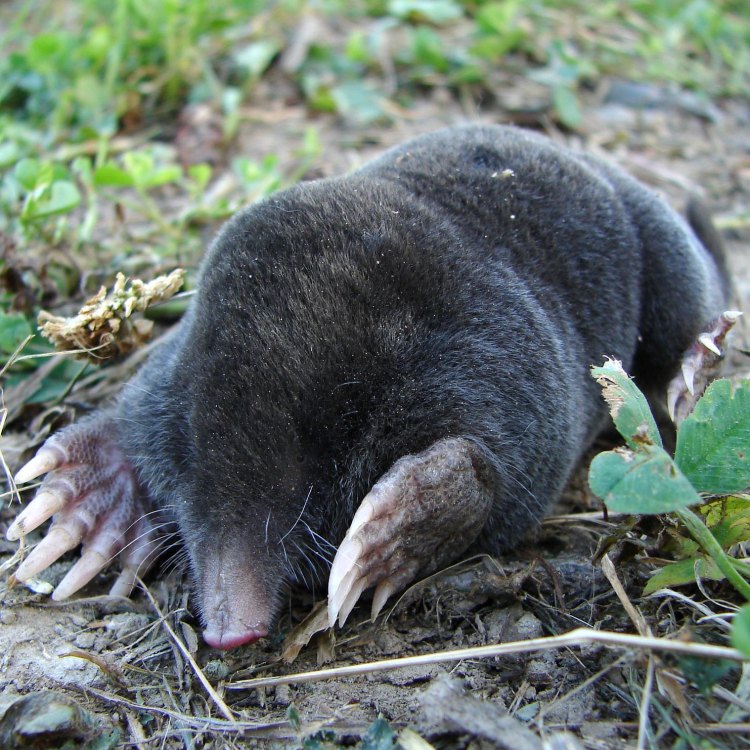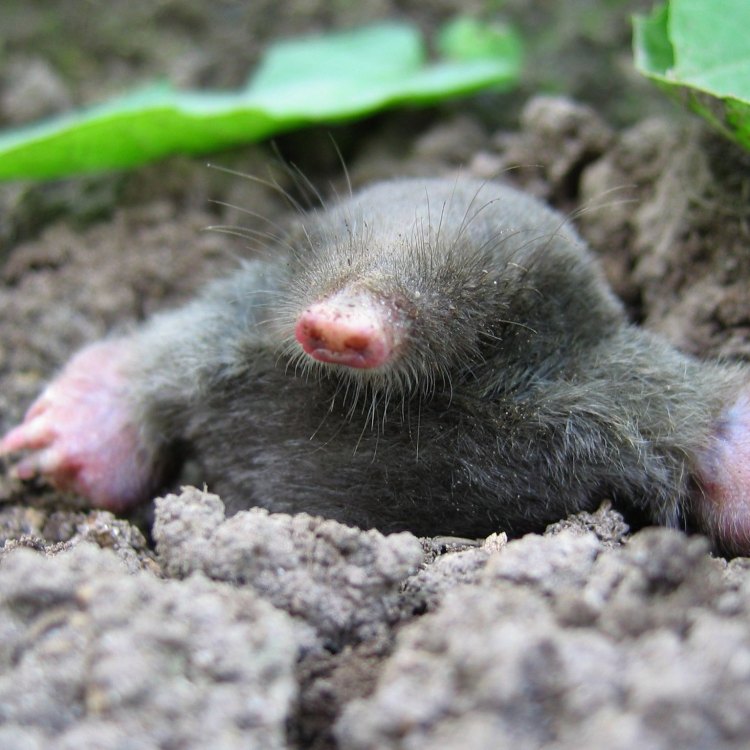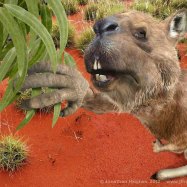
Mole
4-8 inches
Did you know that moles, commonly found in gardens, lawns, and woodlands, belong to the Talpidae family? These cylindrical-shaped animals are small in size, measuring 4-8 inches in length. With their strong front paws and keen sense of smell, moles are expert diggers and can create elaborate underground tunnel systems. Keep an eye out for these elusive creatures the next time you're out in nature!
Animal Details Summary:
Common Name: Mole
Kingdom: Animalia
Habitat: Underground burrows
The Fascinating Life of the Mole: A Subterranean Master of Survival
What comes to mind when you think of a mole? Perhaps a small, furry creature that lives in the ground and is rarely seen by humans. However, this unassuming animal has a remarkable story to tell. The mole, scientifically known as Talpidae, is a member of the Animalia kingdom, Chordata phylum, and Mammalia class. It belongs to the Eulipotyphla order and the Talpidae family Mole. Its name, mole, comes from the German word "moldwurf," which means "earth thrower." Let's excavate deeper into the fascinating world of moles and uncover the secrets of their underground lifestyle.A Burrowing Master
Moles are famous for their underground lifestyle. They spend nearly their entire lives burrowing and tunneling, making their home in the underground world. Their front paws are uniquely designed for digging, with wide, shovel-like claws that they use to displace the soil quickly. This allows them to move through the ground effortlessly. In fact, these animals can dig at an impressive speed of 6 meters (20 feet) per hour.Moles' burrows are intricate and elaborate systems, containing several entrances and tunnels that can span hundreds of meters. They are also skilled architects, incorporating chambers for sleeping, storing food, and raising young Miniature Pinscher. But what is the purpose of all this hard work and construction? Moles use their burrows for protection, shelter, and hunting. They are well adapted to the underground lifestyle and spend most of their day resting in their burrows and occasionally venturing out for food.
The burrows also provide excellent insulation, keeping the moles warm during the cold winter months. They have a remarkable tolerance for low oxygen levels, allowing them to burrow deep underground, even in areas with poor ventilation.
The Insectivorous Diet
Moles are strict insectivores, meaning they feed exclusively on insects. Their main food source includes earthworms, grubs, ants, and other small invertebrates found in the soil. They have specialized saliva that contains a toxin to paralyze their prey, making it easier to catch them. Interestingly, moles have a high metabolism and must consume their body weight in food every day to survive.Their diet plays a crucial role in the ecosystem, as moles help control insect populations, preventing them from becoming pests. This makes them a friend to farmers and gardeners. Additionally, their burrowing activities aerate the soil, improving its nutrient content, and providing channels for water and air to reach plant roots.
Global Distribution
You may have thought that moles are only found in your backyard, but they actually have a widespread global distribution. They can be found in North America, Europe, and Asia, with species varying in size and coloration. These animals are highly adaptable and can thrive in a variety of environments.Country of origin varies depending on the species of mole. Some of the most common species are the Eastern mole, found in the eastern United States; the European mole, found throughout Europe; and the Russian mole, found in eastern Asia.
The Surprising Coloration and Body Shape
Moles may not be known for their beauty, but they have a unique coloration and body shape that makes them stand out in the animal kingdom. Most moles have dark gray or black fur, which allows them to blend in with their underground homes. This also provides protection from predators, as they are rarely seen in their natural habitat.In addition to their coloration, moles have a cylindrical body shape, which is well-suited for their underground lifestyle. Their bodies are about 4-8 inches long, with short, dense fur and small eyes and ears. Their front paws are extremely powerful, while their hind paws are much smaller and used primarily for balance.
Threats to Survival
Despite their remarkable survival skills, moles face several threats in the wild. One of the main threats is habitat loss, as humans continue to expand and build on their natural habitat. Pesticides and other chemicals used in agriculture can also harm moles and their food sources. Additionally, due to their underground lifestyle, they are often mistaken and injured by lawnmowers and other garden tools.Another threat is their use in traditional medicine and folk beliefs. In some parts of China, mole meat is considered a delicacy, and their blood and body parts are used in herbal remedies. These practices have led to a decline in mole populations in some areas.
The Importance of Conservation
Moles may not be considered the most glamorous animals, but they play a crucial role in the ecosystem. As insectivores, they help control insect populations, maintaining balance in the food chain. Their burrowing activities also contribute to soil health, improving plant growth and preventing erosion.It's essential to raise awareness about the importance of preserving moles and their natural habitat. Conservation efforts can include creating protected areas and implementing sustainable farming practices that do not harm these animals and their food sources.
In Conclusion
In conclusion, moles are more than just underground dwellers. They are remarkable creatures with unique adaptations that allow them to thrive in a harsh environment. From their skilled digging abilities to their important role in controlling insect populations, moles have proven to be valuable members of the animal kingdom.As we learn more about these fascinating creatures, it's crucial to ensure their protection. By understanding their importance and their struggles, we can work towards preserving their existence and allowing them to continue living in their underground world. Let's appreciate and celebrate the resilience and adaptability of the humble mole.

Mole
Animal Details Mole - Scientific Name: Talpidae
- Category: Animals M
- Scientific Name: Talpidae
- Common Name: Mole
- Kingdom: Animalia
- Phylum: Chordata
- Class: Mammalia
- Order: Eulipotyphla
- Family: Talpidae
- Habitat: Underground burrows
- Feeding Method: Insectivorous
- Geographical Distribution: North America, Europe, Asia
- Country of Origin: Various
- Location: Gardens, lawns, meadows, woodlands
- Animal Coloration: Dark gray or black
- Body Shape: Cylindrical
- Length: 4-8 inches

Mole
- Adult Size: 4-8 inches
- Average Lifespan: 2-3 years
- Reproduction: Sexual
- Reproductive Behavior: Polygynous
- Sound or Call: Low grunting sounds
- Migration Pattern: Non-migratory
- Social Groups: Solitary
- Behavior: Nocturnal
- Threats: Habitat loss, agricultural practices
- Conservation Status: Least Concern
- Impact on Ecosystem: Aerate soil, control insect populations
- Human Use: None
- Distinctive Features: Blindness, large front paws, velvety fur
- Interesting Facts: Moles can dig tunnels at a rate of 15 feet per hour
- Predator: Owls, foxes, cats, dogs

Talpidae
The Fascinating World of Moles: Secrets of Small But Mighty Creatures
Moles are one of the most intriguing creatures on earth, living a secret life underground and rarely seen by humans. These small but mighty mammals have captured our curiosity and imagination for centuries with their unique physical features, behavioral patterns, and interesting facts. In this article, we will dive deep into the fascinating world of moles and uncover the secrets of these elusive creatures.Adult Size and Lifespan
The first thing that comes to mind when we think of moles is their small size PeaceOfAnimals.Com. These creatures can grow anywhere between 4 to 8 inches, making them one of the smallest mammals in the world. Despite their small size, they can weigh up to 4 ounces due to their compact and muscular bodies.
Moles also have a relatively short lifespan compared to other mammals, with an average lifespan of 2-3 years. This short lifespan is due to their solitary and nocturnal behavior, making it difficult for them to mate and reproduce. However, some exceptional moles have been known to live up to 6 years in captivity.
Reproduction and Reproductive Behavior
Moles have a unique reproductive behavior that sets them apart from many other mammals. They are polygynous animals, meaning that one male mole can mate with multiple female moles during the breeding season. This behavior results in a higher number of offspring, ensuring the survival of the species.
The breeding season for moles typically occurs between February and March, and the gestation period lasts for about 5-6 weeks Megalochelys. Female moles usually give birth to 3-6 babies, also known as pups, in a single litter. These pups are born blind, hairless, and completely dependent on their mother for survival.
Sound or Call
Moles are not known for making a lot of noise, but they do communicate in their own way. These tiny creatures make low grunting sounds, which can travel through the ground, helping them to communicate with other moles. This communication is essential, especially during the mating season, to attract potential mates.
Migration Pattern and Social Groups
Most animals have a migration pattern, but moles are an exception. These creatures are non-migratory, meaning that they do not travel long distances for food or shelter. Instead, they stay in their underground tunnels, where they have everything they need to survive.
Moles are also solitary animals, meaning that they prefer to live alone. They have minimal interaction with other moles, except during the breeding season. This solitary behavior is due to the fact that their tunnels provide them with enough food and shelter, eliminating the need for social groups.
Behavior and Nocturnal Lifestyle
Moles are primarily nocturnal creatures, meaning that they are most active at night. This behavior is due to the fact that they have very sensitive eyes and are adapted to see in low light conditions. This nocturnal lifestyle also helps them avoid predators, which are more active during the day.
One of the most interesting behaviors of moles is their digging. These creatures have powerful front paws that are specially designed for digging. They use their large front paws to move soil and create complex underground tunnels, which are their homes, food storages, and protection from predators.
Threats and Conservation Status
Like many other creatures, moles are facing threats to their survival. The main threat to moles is habitat loss due to human activities such as deforestation, urbanization, and agricultural practices. These activities destroy their underground tunnels and diminish their food sources, making it challenging for them to survive.
Despite these threats, moles are currently listed as "Least Concern" on the International Union for the Conservation of Nature's (IUCN) Red List. This is due to the fact that they have a vast distribution range and can adapt to different habitats. However, continued efforts are necessary to preserve their natural habitats and minimize human impact on their survival.
Impact on Ecosystem and Human Use
Moles may seem like insignificant creatures, but they play a vital role in maintaining a healthy ecosystem. One of their most significant contributions is aerating the soil. As they dig and create their underground tunnels, they loosen and mix the soil, allowing for better water and air circulation. This helps with plant growth and nutrient absorption in the soil.
Moles also help control the population of insects, grubs, and other small creatures in their habitat. Their underground tunnels are like a natural pest control system, as they consume insects and larvae that can be harmful to vegetation. This makes them beneficial to farmers and gardeners in managing insect populations without the use of harmful chemicals.
Distinctive Features and Interesting Facts
Moles have several distinctive features that make them stand out from other animals. One of their most famous features is their blindness. These creatures have small, nearly invisible eyes, which are covered in fur to protect them from dirt and debris while digging. However, despite their poor eyesight, they have excellent hearing and sense of smell, which helps them navigate and locate food in the dark underground tunnels.
Moles also have large front paws with sharp claws that are excellent for digging and capturing prey. These front paws are equipped with sensory receptors, making them highly sensitive to touch. This helps them to feel vibrations in the soil and detect the presence of prey.
But perhaps one of the most interesting facts about moles is their digging speed. These small creatures can dig tunnels at an astonishing rate of 15 feet per hour, making them one of the fastest digging animals in the world. This is due to their highly efficient front paws and powerful muscles, which allow them to move a large amount of soil in a short period.
Predators and Human Interaction
Even with their impressive digging speed, moles are not immune to predators. Their underground lifestyle may provide them with protection, but they are still vulnerable to predators such as owls, foxes, cats, and dogs, which can dig them out of their tunnels and catch them on the surface.
Despite their unique physical features and interesting behaviors, moles have little interaction with humans. They are rarely seen or captured for human use, as they are not commonly kept as pets or used for any specific purpose. However, they do have their supporters and admirers, who appreciate their role in maintaining a healthy ecosystem.
In conclusion, moles may seem like small and unremarkable creatures, but they hold a significant place in the world of mammals. Their distinctive features, behavioral patterns, and contributions to the ecosystem make them a fascinating species worthy of admiration and protection. So next time you spot a mole or its underground tunnel, remember the secrets and wonders of these small but mighty creatures that often go unseen.

The Fascinating Life of the Mole: A Subterranean Master of Survival
Disclaimer: The content provided is for informational purposes only. We cannot guarantee the accuracy of the information on this page 100%. All information provided here may change without prior notice.












